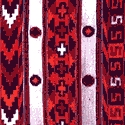
Saris/Unstitched Garments, Textiles, Weaving, Spinning, Khadi
Maheshwari Weaving of Maheshwar, Madhya Pradesh
The sari derives its name from the town of Maheshwar in West Nimad district of Madhya Pradesh, located on the banks of the Narmada river. Legend has it that it was set up by the Queen Ahilya Bai Holkar – the light, yet rich maheshwari was once the exclusive privilege of royalty. Ahilya Bai built a temple and a palace with beautiful carvings – it is estimated that these could well have provided the inspiration for the designs of the maheshwari sari.
The sari is comprised of either pure cotton or of mixed silk and cotton thread. Silk warp with a fine count and cotton weft is being used in the weaving. There is often a narrow border of zari or contrasting coloured silk, intricately woven in geometric designs. The pallus are woven with a silk weft.
-
Field: Usually there are no motifs in the main field. The buttis so common to the chanderi are definitely not in the maheshwari, though very fine checks or stripes can sometimes be found in the field.
-
Borders: Traditionally, these have narrow bands of supplementary-warp patterning in zari or coloured silk. (Today, maheshwari borders are often broader.)
-
End-piece: The pallu (end-piece) is quite distinct – with broad and narrow white bands (either the five-band Maharastrian style, or a series of bands of different widths) across the base colour of the sari.
The colours and textures are a play of weft colours, subtly different from the warp yarn. Soft and gentle colours are more common; occasionally a brighter colour can be found.

